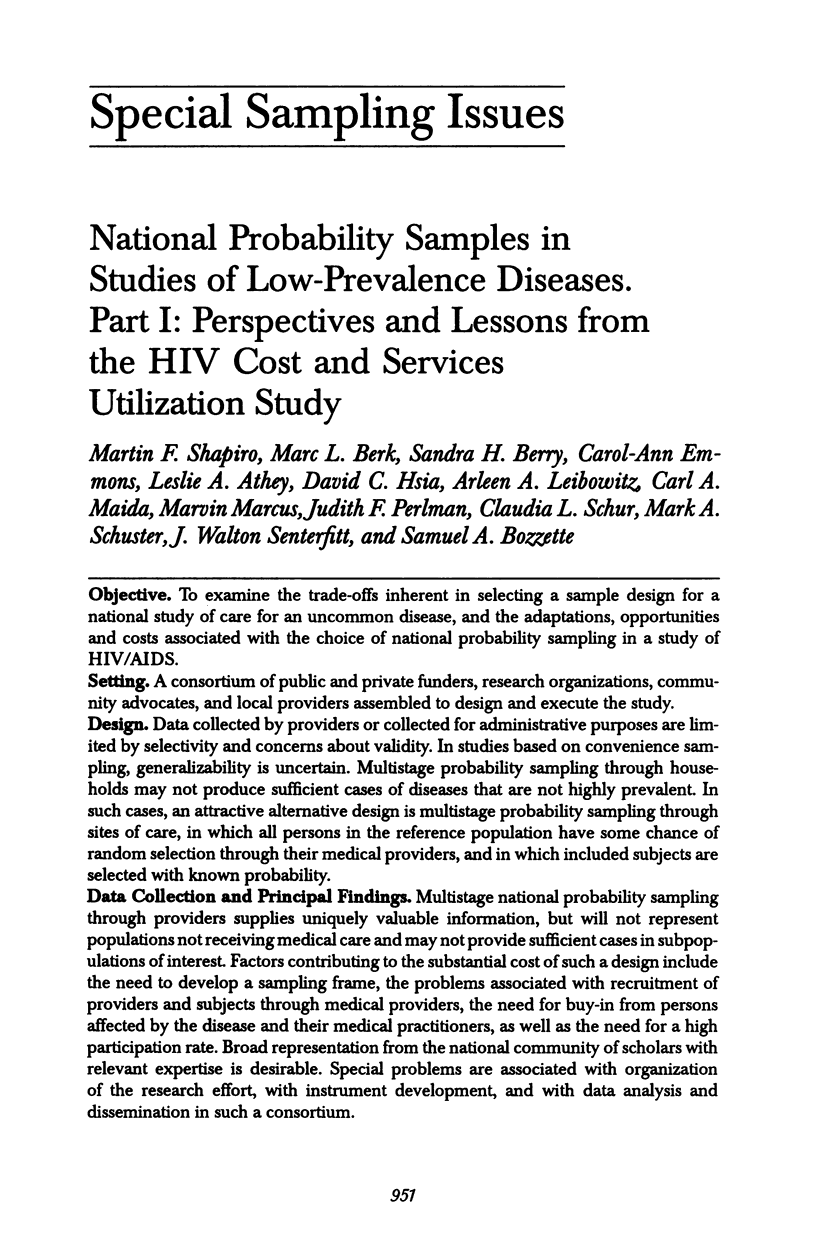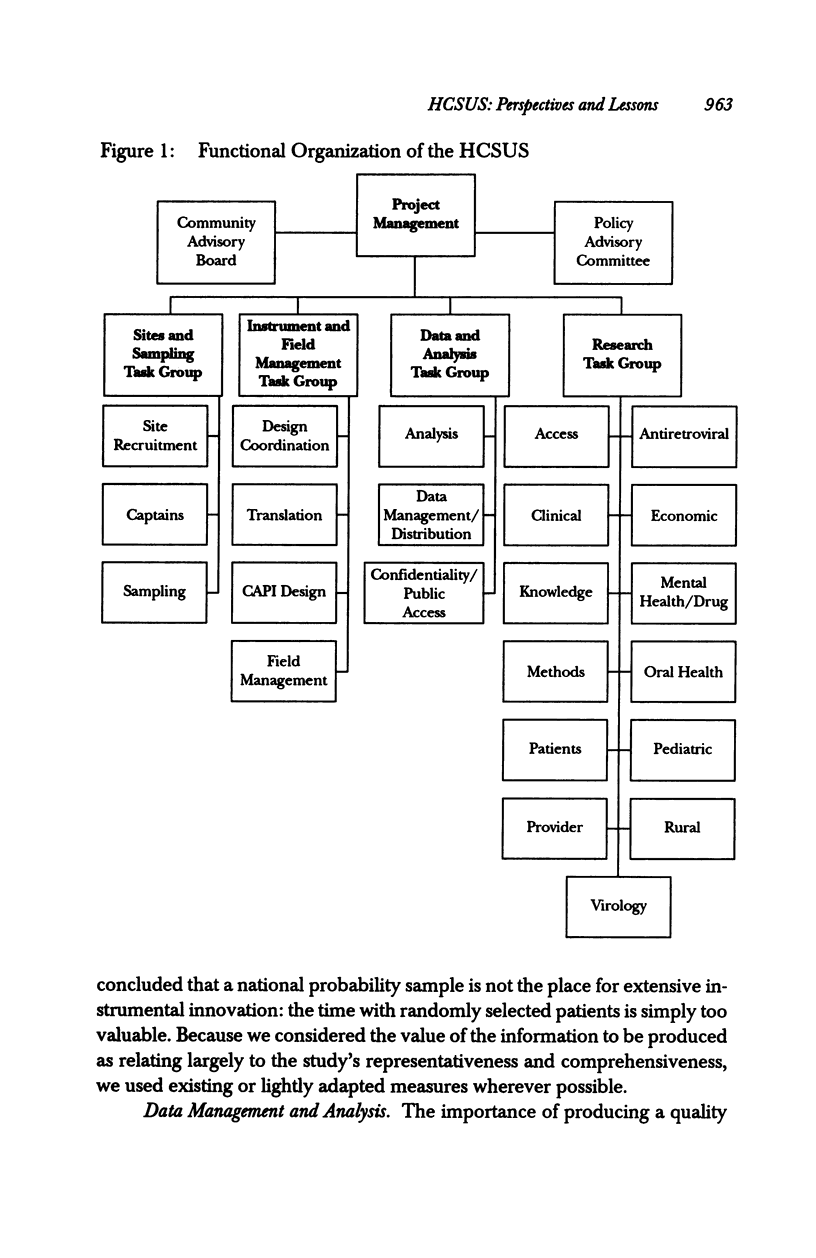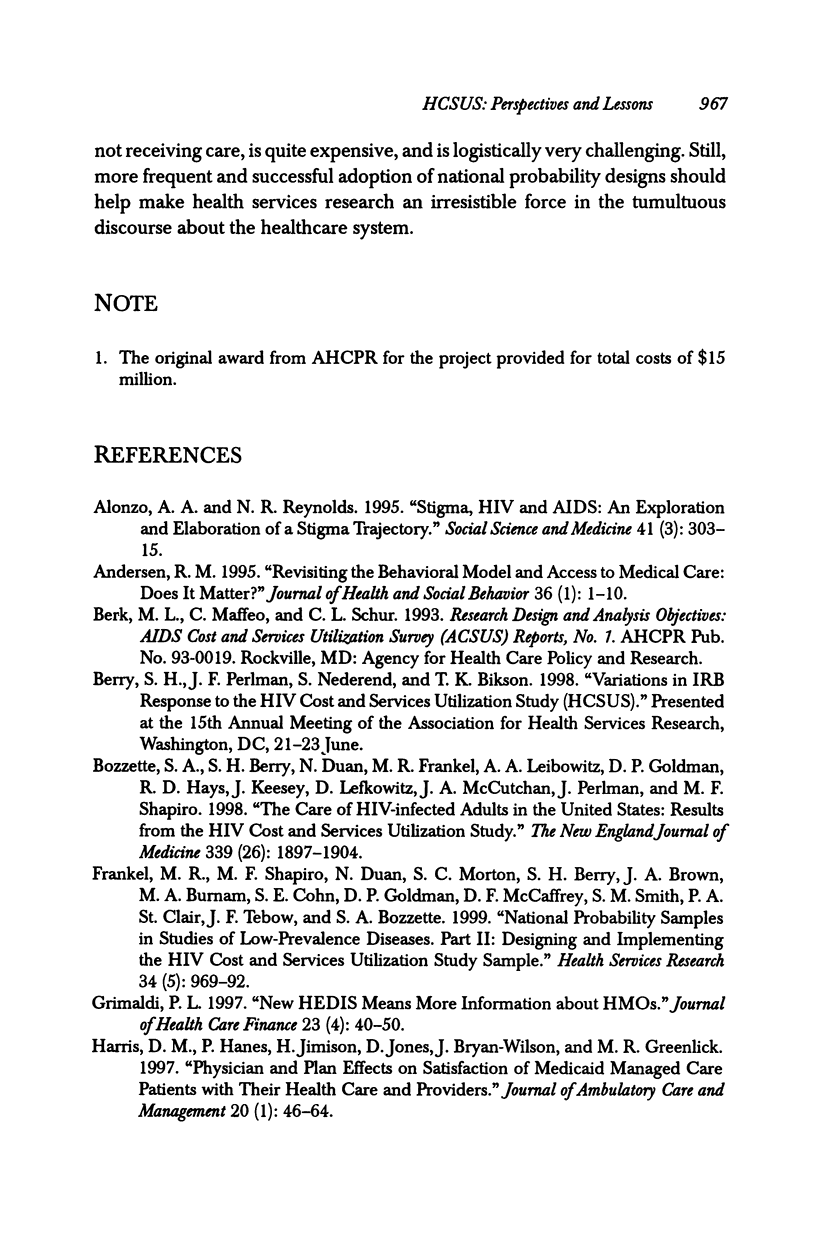Abstract
OBJECTIVE: To examine the trade-offs inherent in selecting a sample design for a national study of care for an uncommon disease, and the adaptations, opportunities and costs associated with the choice of national probability sampling in a study of HIV/AIDS. SETTING: A consortium of public and private funders, research organizations, community advocates, and local providers assembled to design and execute the study. DESIGN: Data collected by providers or collected for administrative purposes are limited by selectivity and concerns about validity. In studies based on convenience sampling, generalizability is uncertain. Multistage probability sampling through households may not produce sufficient cases of diseases that are not highly prevalent. In such cases, an attractive alternative design is multistage probability sampling through sites of care, in which all persons in the reference population have some chance of random selection through their medical providers, and in which included subjects are selected with known probability. DATA COLLECTION AND PRINCIPAL FINDINGS: Multistage national probability sampling through providers supplies uniquely valuable information, but will not represent populations not receiving medical care and may not provide sufficient cases in subpopulations of interest. Factors contributing to the substantial cost of such a design include the need to develop a sampling frame, the problems associated with recruitment of providers and subjects through medical providers, the need for buy-in from persons affected by the disease and their medical practitioners, as well as the need for a high participation rate. Broad representation from the national community of scholars with relevant expertise is desirable. Special problems are associated with organization of the research effort, with instrument development, and with data analysis and dissemination in such a consortium. CONCLUSIONS: Multistage probability sampling through providers can provide unbiased, nationally representative data on persons receiving regular medical care for uncommon diseases and can improve our ability to accurately study care and its outcomes for diseases such as HIV/AIDS. However, substantial costs and special circumstances are associated with the implementation of such efforts.
Full text
PDF

















Selected References
These references are in PubMed. This may not be the complete list of references from this article.
- Alonzo A. A., Reynolds N. R. Stigma, HIV and AIDS: an exploration and elaboration of a stigma trajectory. Soc Sci Med. 1995 Aug;41(3):303–315. doi: 10.1016/0277-9536(94)00384-6. [DOI] [PubMed] [Google Scholar]
- Andersen R. M. Revisiting the behavioral model and access to medical care: does it matter? J Health Soc Behav. 1995 Mar;36(1):1–10. [PubMed] [Google Scholar]
- Bozzette S. A., Berry S. H., Duan N., Frankel M. R., Leibowitz A. A., Lefkowitz D., Emmons C. A., Senterfitt J. W., Berk M. L., Morton S. C. The care of HIV-infected adults in the United States. HIV Cost and Services Utilization Study Consortium. N Engl J Med. 1998 Dec 24;339(26):1897–1904. doi: 10.1056/NEJM199812243392606. [DOI] [PubMed] [Google Scholar]
- Frankel M. R., Shapiro M. F., Duan N., Morton S. C., Berry S. H., Brown J. A., Burnam M. A., Cohn S. E., Goldman D. P., McCaffrey D. F. National probability samples in studies of low-prevalence diseases. Part II: Designing and implementing the HIV cost and services utilization study sample. Health Serv Res. 1999 Dec;34(5 Pt 1):969–992. [PMC free article] [PubMed] [Google Scholar]
- Grimaldi P. L. New HEDIS means more information about HMOs. J Health Care Finance. 1997 Summer;23(4):40–50. [PubMed] [Google Scholar]
- Harris D. M., Hanes P., Jimison H., Jones D., Bryan-Wilson J., Greenlick M. R. Physician and plan effects on satisfaction of Medicaid managed care patients with their health care and providers. J Ambul Care Manage. 1997 Jan;20(1):46–64. doi: 10.1097/00004479-199701000-00007. [DOI] [PubMed] [Google Scholar]
- Hellinger F. J., Fleishman J. A., Hsia D. C. AIDS treatment costs during the last months of life: evidence from the ACSUS. Health Serv Res. 1994 Dec;29(5):569–581. [PMC free article] [PubMed] [Google Scholar]
- Iezzoni L. I., Shwartz M., Ash A. S., Mackiernan Y. D. Using severity measures to predict the likelihood of death for pneumonia inpatients. J Gen Intern Med. 1996 Jan;11(1):23–31. doi: 10.1007/BF02603481. [DOI] [PubMed] [Google Scholar]
- Lehman A. F. Measuring quality of life in a reformed health system. Health Aff (Millwood) 1995 Fall;14(3):90–101. doi: 10.1377/hlthaff.14.3.90. [DOI] [PubMed] [Google Scholar]
- Marx R., Katz M. H., Park M. S., Gurley R. J. Meeting the service needs of HIV-infected persons: is the Ryan White CARE Act succeeding? J Acquir Immune Defic Syndr Hum Retrovirol. 1997 Jan 1;14(1):44–55. doi: 10.1097/00042560-199701010-00008. [DOI] [PubMed] [Google Scholar]
- O'Malley C. Quality measurement for health systems: accreditation and report cards. Am J Health Syst Pharm. 1997 Jul 1;54(13):1528–1535. doi: 10.1093/ajhp/54.13.1528. [DOI] [PubMed] [Google Scholar]
- Thomas M. R., Stoyva J., Rosenberg S. A., Kassner C., Fryer G. E., Giese A. A., Dubovsky S. L. Selection bias in an inpatient outcomes monitoring project. Gen Hosp Psychiatry. 1997 Jan;19(1):56–61. doi: 10.1016/s0163-8343(96)00118-1. [DOI] [PubMed] [Google Scholar]
- Ware J. E., Jr, Bayliss M. S., Rogers W. H., Kosinski M., Tarlov A. R. Differences in 4-year health outcomes for elderly and poor, chronically ill patients treated in HMO and fee-for-service systems. Results from the Medical Outcomes Study. JAMA. 1996 Oct 2;276(13):1039–1047. [PubMed] [Google Scholar]
- Welch W. P., Welch H. G. Fee-for-data: a strategy to open the HMO black box. Health Aff (Millwood) 1995 Winter;14(4):104–116. doi: 10.1377/hlthaff.14.4.104. [DOI] [PubMed] [Google Scholar]


